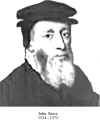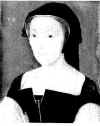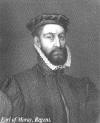|
John Knox;
Mary of Guise, Queen Regent; and the First
Reformation.
 John John
Knox has been called many things but in the context of the
religious reformation then taking place, the comment by
Mary, Queen of Scots, sums him up. She considered
him “ the most dangerous man in all the realm” –
meaning his ideas. Knox was first a priest but having
heard George Wishart preach he took up the reformed,
Protestant, doctrines in 1543. After some time as a
minister in England he went to Frankfort in Germany and to
Geneva where he preached to
English and Scottish exiles. In Geneva he was
influenced by the teachings of John Calvin which he
adopted and subsequently brought with him to Scotland.
Knox is sometimes unfairly cast as
a zealot and a fanatic when he was simply very
earnest in
his beliefs. As with the later Covenanters, he lived and
breathed his beliefs with a fervour that we cannot really
appreciate in the laid back and largely pagan society of
the twenty first century. But these were strengths, to
which should be added a commanding intellect that could
overawe his audience, and a penetrating mind. He was also
possessed of very wide experience from his travels and
associations with some of the most learned men in Europe.
In short he possessed the qualities needed to be a leader,
and capable of standing up to the staunchly Catholic Queen
Regent, Mary of Guise, mother of Mary Queen of Scots.
In Scotland the
death of James V on 14 December 1542 brought the one week
old Mary to the throne and with her accession a battle for
the Regency. The Earl of Arran was Regent for some years
during which there were several incursions into Scotland
by the English. Scotland, meanwhile, was under great
pressure from the French who supported the Queen Mother,
Mary of Guise in her bid to be Queen
Regent. On the pretext of
keeping order the Regent Mary was supplied with French
troops but this was a tactic to put pressure on England
with whom war was looming. With French forces on its
borders, the English responded to the threat. The Duke of
Somerset defeated the Scots army at Pinkie on ‘Black
Saturday,’ 9 September 1547. This was followed by the
building of a chain of forts along the border and several
years of relative peace. However, French influence
remained in Scotland and more French troops arrived to
occupy Edinburgh causing the English to finally withdraw.
The young Mary, Queen of Scots, was sent to France where
she spent the next thirteen years and married the Dauphin,
Francis, later King Francis II.
While the young
Scottish queen was in France, there followed a concurrent
period of upheaval in Scotland as Mary of Guise sought to
impose her authority and that of the Catholic church. Her
position and French influence was improved when she became
Queen Regent in 1554 but she made enemies through her
appointment of Frenchmen to positions of power.
Into this cauldron of intrigue
came John Knox in 1555 who had been invited by a growing
evangelical movement to preach and plan for the
establishment of a reformed faith. Knox preached at Duns
House, between Montrose and Berwick—the home of John
Erskine; at Calder House, West Lothian, the home of Sir
James Sandilands; Finlayston House, Kilmalcolm, the home
of Alexander Cunningham, Fifth Earl of Glencairn; at
Castle Campbell, home of Archibald Campbell (later Fifth
Earl of Argyll); and at other homes in Ayr, Barr, Gadgirth,
Kinzeancleuch, and Ochiltree
in Ayrshire.
Other supporters in the nobility who were strengthened in
their faith by Knox’s endeavours included Lord Erskine
(later Sixth Earl of Mar) and Lord James Stewart
 (later (later
Earl of Moray and Regent.)
These were men of great influence and power who
were able to summon substantial military forces to their
aid and had to be regarded with respect. But even so, with
French soldiers in support of Mary of Guise, they had to
tread carefully. Even the fearless Knox returned to Geneva
for a while in July 1556.
The Queen Regent then sought to raise a standing army to
bring pressure on England who was close to war with
France. However, she encountered the strong
resistance of the property owners who would be forced to
pay for it. A protest meeting of over three hundred lairds
in the Abbey Church of Holyrood in 1556 caused her to
yield from the proposal. In England Mary Tudor,
eldest daughter of Henry VIII and now Queen of England,
declared war on France in 1557. This spurred the Queen
Regent in Scotland to assemble an army near Kelso to
attack England. But the assembled Lords of Arran, Huntly,
Argyll, and others, declared themselves as assembled only
for the defence of Scotland and not for aggression against
England.
Meanwhile, in March 1557 the
Lords had written to Knox and asked him to return to
Scotland. In reply Knox encouraged them to be bold and
public, reckoning that their power and influence could
help turn the tide against Romanism. This they agreed to
do. On 3 December 1557 the first “Band” or Covenant
was signed by the Lairds of the Mearns to establish the
word of God and to labour for the institution and support
of “faithful ministers purely and truly to minister
Christ’s Evangel and Sacraments to His people.”
Their objectives were very simple and explicit:
that the public prayers and administration of the
sacraments by ministers should be celebrated in their
mother tongue so that all people might understand them,
and that the election of ministers according to the custom
of the primitive Church, should be made by the people. The signatories to the Band or Covenant were
Archibald Campbell, Earl of Argyll; the Earl of Glencairn;
the Earl of Morton; Archibald Campbell, Lord of Lorne; and
John Erskine of Dun.
Thus came into being “The
Congregation of Jesus Christ” or “The
 Lords Lords
of the Covenant” which grew to become a formal opposition
to Catholicism. The Congregation then demanded religious
freedom to which the Regent responded with the execution
for heresy of the eighty-two-year-old
Walter Mill on 28 April 1558.
He was a former priest who had stopped giving the Mass and
joined the evangelical movement. The Congregation
immediately demanded that the clergy’s power to try for
heresy be suspended but the Regent declined to present the
matter to the Estates. This prompted the Congregation to
make their own direct Protestation to Parliament and to
declare that they intended to follow their own
consciences.
The death of England’s Mary
Tudor later that year and the accession of the Protestant
Elizabeth I gave hope for the Protestant cause in
Scotland. An immediate consequence of Mary’s death was the
return of many committed Protestants who had been exiled
earlier to the Continent. Among them were those from
Geneva who had come under the direct influence of Calvin.
These people were keen to remove any remaining signs of
Popery and became an important element in the subsequent
attempts to reform the Church of England.
In
Scotland, events came to a
head when the Regent Queen Mary of Guise summoned
four preachers—Paul Methven, John Christison, William
Harlow, and John Willock—to Stirling to answer charges of
usurping the ministerial office and preaching sedition.
The trial was appointed to take place on 10 May 1559 with
the expectation that the ministers would be sentenced to
banishment. The Congregation took up the preachers’ cause
and assembled at Perth to accompany the accused to see the
Regent. Meanwhile, in Edinburgh, great consternation arose
amongst the Papists when John Knox returned from the
continent and preached there before making his way to
preach at Crail, St. Andrews, Dundee, and Perth.
In St. John’s
Church, Perth, there occurred the incident that changed
the face of Scotland when a priest was preparing to say
Mass. A boy [more likely a young man] made some disparaging remarks, and was cuffed
round the ear. In response, the boy allegedly threw a
stone at images on the high altar and broke one.
Onlookers then threw more stones at the priest and
destroyed the ornaments of the church. From this flowed
attacks on the monasteries of the Black Friars, Grey
Friars, and Carthusians which were all ransacked and
gutted. The scenes were repeated in St. Andrews and Scone
where the ornaments were removed, but the
fabric of the buildings themselves was not torn down.
This “rabelling” was seized
upon by Mary of Guise as valid reason to repress the
Protestants by fire and sword. This prompted the friends
of the Congregation from Angus, Mearns, Fife, and Ayrshire
to gather at Perth to defend against the Regent’s French
army who were in Auchterarder, north of Perth.
By June the Congregation was assembled in Edinburgh
but French troops caused them to withdraw to Stirling.
Negotiations continued with the Regent and she eventually
gained agreement for the armed supporters of the
Congregation to stand down. At this juncture the Earl of
Agyll and Lord James Stewart transferred their allegiance
to the Congregation because they were disgusted with the
Regent’s broken promises to withdraw the French soldiers.
Another Band, the Second Covenant, was sworn for mutual
defence and the abolition of Popery by the Lords and
Barons at Edinburgh on 13 July 1559. On August 1 another
Band (the Third Covenant) was sworn in Stirling to work
and negotiate together, and to keep one another informed.
In August 1559,
French troops landed at Leith and began fortifying it. Here they butchered Scottish women, children,
and old men, dangled their bodies over the walls. The
Queen Regent the commented it was “a pleasing tapestry.”
In October the Congregation declared the Regent
Mary deposed in the name of her daughter who, it was
alleged, had sold the country to France.
Scottish pleas
for help from Elizabeth I of England were finally heard
and a large army assembled at Berwick where, on 27
February 1560, an agreement securing Scotland’s liberties
was signed with the Lords of the Congregation.
Within a month
Leith was surrounded and the English fleet lay offshore.
There followed another Band (the Fourth Covenant) on the
27 April 1560 to join with the English to remove the
French troops.
This was
the first Covenant to combine religious and political
demands.
On June 11, the
Regent Mary died in Edinburgh Castle probably from dropsy.
Her death ended the immediate influence of the Guise
family and that of France in Scotland.
The Treaty of Edinburgh, 6
July 1560, settled Scotland’s Protestant independence. In
August 1560, the Estates assembled to formally sanction
the reformed religion, which it did, despite protestations
that the assembly was illegal because it had not been
called by the Queen of Scotland.
The first General Assembly of
the Reformed Church in Scotland was held in Edinburgh on
20 December 1560 with forty-two members present, only six
of them being ministers. Calderwood’s History
records that they appointed the following ministers and
superintendents.
The ministers were John Knox (Edinburgh),
Christopher Goodman (was at Ayr but translated to St.
Andrews), Adam Heriot (Aberdeen), John Row (St. Johnston –
Perth), Paul Methven (Jedburgh), William Christeson
(Dundee), David Ferguson (Dumfermline), and David Lindsay
(Leith). The superintendents were John Spottiswood (Lothians);
John Wynram (Fife); John Willock (Glasgow and the West);
John Erskine, Laird of Dun (Angus and the Mearns); and
John Carswell (Argyll and the Isles).
The Assembly met in the old
Chapel of St. Magdalene in Cowgate, Edinburgh, and did so
under its own authority founded on the Word of God.
Importantly the first session wisely took the precaution
to authorise the Moderator ( possibly Knox at the time) to
call future meetings. This precedent was carried on for
some twenty years without the presence of a commissioner
on behalf of the sovereign—despite the intervention of
Maitland of Lethington who questioned the absence of the
Queen’s authority. John Knox responded with the prophetic
words
“Tack from us the fredome
of Assemblies, and tack from us the Evangell for without
Assemblies, how shall good ordour and unitie in doctrine
be keapt ?”:
which is precisely what King
James VI did in later years.
Next: Mary, Queen of Scots
The Doctrine of Knox
|